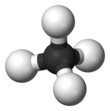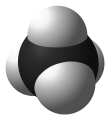Methane
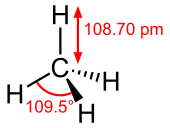
| |||
| |||
| Names | |||
|---|---|---|---|
| Preferred IUPAC name
Methane[1] | |||
| Systematic IUPAC name
Carbane (never recommended[1]) | |||
Other names
| |||
| Identifiers | |||
3D model (JSmol)
|
|||
| 1718732 | |||
| ChEBI | |||
| ChEMBL | |||
| ChemSpider | |||
| ECHA InfoCard | 100.000.739 | ||
| EC Number |
| ||
| 59 | |||
| KEGG | |||
| MeSH | Methane | ||
PubChem CID
|
|||
| RTECS number |
| ||
| UN number | 1971 | ||
CompTox Dashboard (EPA)
|
|||
| |||
| |||
| Properties | |||
| CH4 | |||
| Molar mass | 16.043 g·mol−1 | ||
| Appearance | Colorless gas | ||
| Odor | Odorless | ||
| Density |
| ||
| Melting point | −182.5 °C; −296.4 °F; 90.7 K | ||
| Boiling point | −161.50 °C; −258.70 °F; 111.65 K[3] | ||
| 22.7 mg·L−1 | |||
| Solubility | Soluble in ethanol, diethyl ether, benzene, toluene, methanol, acetone and insoluble in water | ||
| log P | 1.09 | ||
Henry's law
constant (kH) |
14 nmol·Pa−1·kg−1 | ||
| Conjugate acid | Methanium | ||
| −12.2×10−6 cm3·mol−1 | |||
| Structure | |||
| Td | |||
| Tetrahedron | |||
| 0 D | |||
| Thermochemistry | |||
Heat capacity (C)
|
35.69 J·(K·mol)−1 | ||
Std molar
entropy (S⦵298) |
186.25 J·(K·mol)−1 | ||
Std enthalpy of
formation (ΔfH⦵298) |
−74.87 kJ·mol−1 | ||
Std enthalpy of
combustion (ΔcH⦵298) |
−891.1 to −890.3 kJ·mol−1 | ||
| Hazards[4] | |||
| GHS labelling: | |||

| |||
| Danger | |||
| H220 | |||
| P210 | |||
| NFPA 704 (fire diamond) | |||
| Flash point | −188 °C (−306.4 °F; 85.1 K) | ||
| 537 °C (999 °F; 810 K) | |||
| Explosive limits | 4.4–17% | ||
| Related compounds | |||
Related alkanes
|
|||
| Supplementary data page | |||
| Methane (data page) | |||
Except where otherwise noted, data are given for materials in their standard state (at 25 °C [77 °F], 100 kPa).
| |||
Methane (US: /ˈmɛθeɪn/ or UK: /ˈmiːθeɪn/) is a chemical compound with the chemical formula CH4 (one atom of carbon and four atoms of hydrogen). It is a group-14 hydride and the simplest alkane, and is the main constituent of natural gas. The relative abundance of methane on Earth makes it an attractive fuel, though capturing and storing it poses challenges due to its gaseous state under normal conditions for temperature and pressure.
Natural methane is found both below ground and under the sea floor. When it reaches the surface and the atmosphere, it is known as atmospheric methane.[6] The Earth's atmospheric methane concentration has increased by about 150% since 1750, and it accounts for 20% of the total radiative forcing from all of the long-lived and globally mixed greenhouse gases.[7]
History

In November 1776, methane was first scientifically identified by Italian physicist Alessandro Volta in the marshes of Lake Maggiore straddling Italy and Switzerland. Volta was inspired to search for the substance after reading a paper written by Benjamin Franklin about "flammable air".[8] Volta collected the gas rising from the marsh, and by 1778 had isolated the pure gas.[9] He also demonstrated that the gas could be ignited with an electric spark.[9]
The name "methane" was coined in 1866 by the German chemist August Wilhelm von Hofmann.[10] The name was derived from methanol.
Etymology
Etymologically, the word "methane" is coined from chemical suffix "-ane" which represents the substance belonging to alkanes family and the word "methyl" which is derived from German "methyl" (A.D.1840) or directly from French "méthyle" which is a back-formation from French "méthylène" (of which correspondence in English is "methylene") the root of which is coined from Greek "methy"(of which correspondence in English is "mead") and "hyle" (meaning "wood"). The radical is named after this because it was first detected in wood alcohol. The chemical suffix "-ane" is from the coordinating chemical suffix "-ine" which is from Latin feminine suffix "-ina" which is applied to represent abstracts. The coordination of "-ane", "-ene", "-one", etc. is proposed in 1866 by German chemist August Wilhelm von Hofmann (1818-1892).
Properties and bonding
Methane is a tetrahedral molecule with four equivalent C–H bonds. Its electronic structure is described by four bonding molecular orbitals (MOs) resulting from the overlap of the valence orbitals on C and H. The lowest energy MO is the result of the overlap of the 2s orbital on carbon with the in-phase combination of the 1s orbitals on the four hydrogen atoms. Above this energy level is a triply degenerate set of MOs that involve overlap of the 2p orbitals on carbon with various linear combinations of the 1s orbitals on hydrogen. The resulting "three-over-one" bonding scheme is consistent with photoelectron spectroscopic measurements.
At room temperature and standard pressure, methane is a colorless, odorless gas.[11] The familiar smell of natural gas as used in homes is achieved by the addition of an odorant, usually blends containing tert-butylthiol, as a safety measure. Methane has a boiling point of −164 °C (−257.8 °F) at a pressure of one atmosphere.[12] As a gas it is flammable over a range of concentrations (5.4–17%) in air at standard pressure.
Solid methane exists in several modifications. Presently nine are known.[13] Cooling methane at normal pressure results in the formation of methane I. This substance crystallizes in the cubic system (space group Fm3m). The positions of the hydrogen atoms are not fixed in methane I, i.e. methane molecules may rotate freely. Therefore, it is a plastic crystal.[14]
Chemical reactions
The primary chemical reactions of methane are combustion, steam reforming to syngas, and halogenation. In general, methane reactions are difficult to control. Partial oxidation to methanol, for example, is challenging because the reaction typically progresses all the way to carbon dioxide and water even with an insufficient supply of oxygen. The enzyme methane monooxygenase produces methanol from methane, but cannot be used for industrial-scale reactions.[15] Some homogeneously catalyzed systems and heterogeneous systems have been developed, but all have significant drawbacks. These generally operate by generating protected products which are shielded from overoxidation. Examples include the Catalytica system, copper zeolites, and iron zeolites stabilizing the Alpha-Oxygen active site.[16]
Acid-base reactions
Like other hydrocarbons, methane is a very weak acid. Its pKa in DMSO is estimated to be 56.[17] It cannot be deprotonated in solution, but the conjugate base is known in forms such as methyllithium.
A variety of positive ions derived from methane have been observed, mostly as unstable species in low-pressure gas mixtures. These include methenium or methyl cation CH+
3, methane cation CH+
4, and methanium or protonated methane CH+
5. Some of these have been detected in outer space. Methanium can also be produced as diluted solutions from methane with superacids. Cations with higher charge, such as CH2+
6 and CH3+
7, have been studied theoretically and conjectured to be stable.[18]
Despite the strength of its C–H bonds, there is intense interest in catalysts that facilitate C–H bond activation in methane (and other lower numbered alkanes).[19]
Combustion

Methane's heat of combustion is 55.5 MJ/kg.[20] Combustion of methane is a multiple step reaction summarized as follows:
Peters four-step chemistry is a systematically reduced four-step chemistry which explains the burning of methane.
Methane Reactions
Given appropriate conditions, methane reacts with as follows:
- X• + CH4 → HX + CH3•
- CH3• + X2 → CH3X + X•
where X is a halogen: fluorine (F), chlorine (Cl), bromine (Br), or iodine (I). This mechanism for this process is called free radical halogenation. It is initiated when UV light or some other radical initiator produces a halogen atom. A two-step chain reaction ensues in which the halogen atom abstracts a hydrogen atom from a methane molecule, resulting in the formation of a hydrogen halide molecule and a methyl radical (CH3•). The methyl radical then reacts with a molecule of the halogen to form a molecule of the halomethane, with a new halogen atom as byproduct. [21] Similar reactions can occur on the halogenated product, leading to replacement of additional hydrogen atoms by halogen atoms with dihalomethane, trihalomethane, and ultimately, tetrahlomethane structures, depending upon reaction conditions and the halogen-to-methane ratio.
Uses
Methane is used in industrial chemical processes and may be transported as a refrigerated liquid (liquefied natural gas, or LNG). While leaks from a refrigerated liquid container are initially heavier than air due to the increased density of the cold gas, the gas at ambient temperature is lighter than air. Gas pipelines distribute large amounts of natural gas, of which methane is the principal component.
Fuel
Methane is used as a fuel for ovens, homes, water heaters, kilns, automobiles,[22][23] turbines, and other things. Activated carbon is used to store methane.
Natural gas
Methane is important for electricity generation by burning it as a fuel in a gas turbine or steam generator. Compared to other hydrocarbon fuels, methane produces less carbon dioxide for each unit of heat released. At about 891 kJ/mol, methane's heat of combustion is lower than any other hydrocarbon but the ratio of the heat of combustion (891 kJ/mol) to the molecular mass (16.0 g/mol, of which 12.0 g/mol is carbon) shows that methane, being the simplest hydrocarbon, produces more heat per mass unit (55.7 kJ/g) than other complex hydrocarbons. In many cities, methane is piped into homes for domestic heating and cooking. In this context it is usually known as natural gas, which is considered to have an energy content of 39 megajoules per cubic meter, or 1,000 BTU per standard cubic foot.
Methane in the form of compressed natural gas is used as a vehicle fuel and is claimed to be more environmentally friendly than other fossil fuels such as gasoline/petrol and diesel.[23] Research into adsorption methods of methane storage for use as an automotive fuel has been conducted.[24]

Liquefied natural gas
Liquefied natural gas (LNG) is natural gas (predominantly methane, CH4) that has been converted to liquid form for ease of storage or transport.
Liquefied natural gas occupies about 1/600th the volume of natural gas in the gaseous state at room temperature and atmospheric pressure. It is odorless, colorless, non-toxic and non-corrosive. Hazards include flammability after vaporization into a gaseous state, freezing, and asphyxia.
The liquefaction process involves removal of certain components, such as dust, acid gases, helium, water, and heavy hydrocarbons, which could cause difficulty downstream. The natural gas is then condensed into a liquid at close to atmospheric pressure (maximum transport pressure set at around 25 kPa or 3.6 psi) by cooling it to approximately −162 °C (111 K).[citation needed]
LNG achieves a higher reduction in volume than compressed natural gas (CNG) so that the energy density of LNG is 2.4 times greater than that of CNG or 60% that of diesel fuel.[25] This makes LNG cost efficient to transport over long distances where pipelines do not exist. Specially designed cryogenic sea vessels (LNG carriers) or cryogenic road tankers are used for its transport. Even if pressurized, methane must be cooled below its critical temperature of −82.3 °C (190.8 K) in order to be liquefied.[26]
LNG, when it is not highly refined for special uses, is principally used for transporting natural gas to markets, where it is regasified and distributed as pipeline natural gas. It can be used in LNG-fueled road vehicles. However, it remains more common to design vehicles to use compressed natural gas. As of 2002[update], the relatively higher cost of LNG production and the need to store LNG in more expensive cryogenic tanks had slowed widespread commercial use.[27]
Natural gas located far from its user base is often released into the atmosphere or flared. Some is subjected to gas to liquids technologies (GTL) to produce liquid fuels, which are more readily transported than methane.
Liquid-methane rocket fuel
Refined liquid methane is used as a rocket fuel.[28] Methane is reported to offer the advantage over kerosene of depositing less carbon on the internal parts of rocket motors, reducing the difficulty of re-use of boosters.
Methane is abundant in many parts of the Solar system and potentially could be harvested on the surface of another solar-system body (in particular, using methane production from local materials found on Mars[29] or Titan), providing fuel for a return journey.[28][30]
Chemical feedstock
Methane is converted to synthesis gas, a mixture of carbon monoxide and hydrogen, by steam reforming. This endergonic process (requiring energy) utilizes catalysts and requires high temperatures, around 700–1100 °C:
- CH4 + H2O → CO + 3 H2
Methane is also subjected to free-radical chlorination in the production of chloromethanes, although methanol is a more typical precursor.[31]
Generation
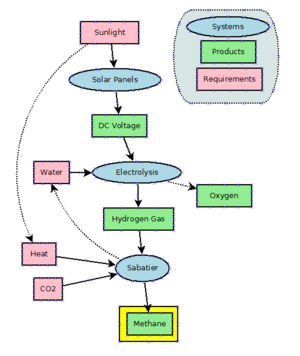
Geological routes
There are two main routes for geological methane generation, organic (thermogenic), and inorganic (abiotic, meaning non-living). Thermally generated methane, referred to as thermogenic, originates from deeper sedimentary strata. Thermogenic methane (CH4) formation occurs due to the breakup of organic matter, forced by elevated temperatures and pressures. This type of methane is considered to be the primary methane type in sedimentary basins, and from an economical perspective the most important source of natural gas. Thermogenic methane components are generally considered to be relic (from an earlier time). Generally, formation of thermogenic methane (at depth) can occur through organic matter breakup, or organic synthesis. Both ways can involve microorganisms (methanogenesis) but may also occur inorganically. The involved anaerobic and aerobic processes can also consume methane, with and without microorganisms. The more important source of methane at depth (crystalline bedrock) is abiotic. Abiotic means that the methane formation took place involving inorganic compounds, without biological activity, magmatic or created at low temperatures and pressures through water-rock reactions.[32][33]
Biological routes
Naturally occurring methane is mainly produced by microbial methanogenesis.[34] This multistep process is used by microorganisms as an energy source. The net reaction is
- CO2 + 8 H+ + 8 e− → CH4 + 2 H2O
The final step in the process is catalyzed by the enzyme Coenzyme-B sulfoethylthiotransferase. Methanogenesis is a form of anaerobic respiration used by organisms that occupy landfill, ruminants (for example cows or cattle), and the guts of termites.
It is uncertain whether plants are a source of methane emissions.[35][36][37]
Industrial routes
There are many technological methane production methods. Methane created from biomass in industrial plants via biological route is called biogas. A more synthetic method to produce methane is hydrogenating carbon dioxide through the Sabatier process. Methane is also a side product of the hydrogenation of carbon monoxide in the Fischer–Tropsch process, which is practiced on a large scale to produce longer-chain molecules than methane. Example of large-scale coal-to-methane gasification is the Great Plains Synfuels plant, started in 1984 in Beulah, North Dakota as a way to develop abundant local resources of low-grade lignite, a resource that is otherwise very hard to transport for its weight, ash content, low calorific value and propensity to spontaneous combustion during storage and transport.
Power to methane is a technology that uses electrical power to produce hydrogen from water by electrolysis and uses the Sabatier reaction to combine hydrogen with carbon dioxide to produce methane. As of 2016, this is mostly under development and not in large-scale use. Theoretically, the process could be used as a buffer for excess and off-peak power generated by highly fluctuating wind generators and solar arrays. The conversion efficiency of power to methane is 49–65%, and full power–methane–power cycle is 30–38%.
Laboratory synthesis
Although methane can in principle be produced by a variety of forcing methods, it is conveniently generated by protonation of methyl lithium and methylmagnesium iodide.
Occurrence
Methane was discovered and isolated by Alessandro Volta between 1776 and 1778 when studying marsh gas from Lake Maggiore. It is the major component of natural gas, about 87% by volume. The major source of methane is extraction from geological deposits known as natural gas fields, with coal seam gas extraction becoming a major source (see Coal bed methane extraction, a method for extracting methane from a coal deposit, while enhanced coal bed methane recovery is a method of recovering methane from non-mineable coal seams). It is associated with other hydrocarbon fuels, and sometimes accompanied by helium and nitrogen. Methane is produced at shallow levels (low pressure) by anaerobic decay of organic matter and reworked methane from deep under the Earth's surface. In general, the sediments that generate natural gas are buried deeper and at higher temperatures than those that contain oil.
Methane is generally transported in bulk by pipeline in its natural gas form, or LNG carriers in its liquefied form; few countries transport it by truck.
Alternative sources

Apart from gas fields, an alternative method of obtaining methane is via biogas generated by the fermentation of organic matter including manure, wastewater sludge, municipal solid waste (including landfills), or any other biodegradable feedstock, under anaerobic conditions. Rice fields also generate large amounts of methane during plant growth. Methane hydrates/clathrates (ice-like combinations of methane and water on the sea floor, found in vast quantities) are a potential future source of methane. Cattle belch methane accounts for 16% of the world's annual methane emissions to the atmosphere.[38] One study reported that the livestock sector in general (primarily cattle, chickens, and pigs) produces 37% of all human-induced methane.[39] Early research has found a number of medical treatments and dietary adjustments that help slightly limit the production of methane in ruminants.[40][41] A 2009 study found that at a conservative estimate, at least 51% of global greenhouse gas emissions were attributable to the life cycle and supply chain of livestock products, meaning all meat, dairy, and by-products, and their transportation.[42] More recently, a 2013 study estimated that livestock accounted for 44 percent of human-induced methane and 14.5 percent of human-induced greenhouse gas emissions.[43] Many efforts are underway to reduce livestock methane production and trap the gas to use as energy.[44] The state of California has been particularly active in this area.[45]
Paleoclimatology research published in Current Biology suggests that flatulence from dinosaurs may have warmed the Earth.[46]
Atmospheric methane
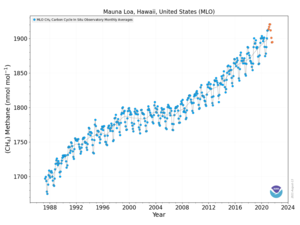
In 2010, methane levels in the Arctic were measured at 1850 nmol/mol. This level is over twice as high as at any time in the last 400,000 years. Historic methane concentrations in the world's atmosphere have ranged between 300 and 400 nmol/mol during glacial periods commonly known as ice ages, and between 600 and 700 nmol/mol during the warm interglacial periods. The Earth's oceans are a potential important source of Arctic methane.[47]
Methane is an important greenhouse gas with a global warming potential of 34 compared to CO2 over a 100-year period, and 72 over a 20-year period.[48][49]
The Earth's atmospheric methane concentration has increased by about 150% since 1750, and it accounts for 20% of the total radiative forcing from all of the long-lived and globally mixed greenhouse gases (these gases don't include water vapor which is by far the largest component of the greenhouse effect).[7]
Clathrates
Methane is essentially insoluble in water, but significant deposits of methane clathrate have been found under sediments on the ocean floors of Earth at large depths. Estimates consider up to 15,000 gigatonnes of carbon may be stored in the form of clathrates (hydrates) in the ocean floor, not accounting for abiotic methane, a relatively newly discovered source of methane, formed below the ocean floor, in the earth crust.[50] It has been suggested, that today's methane emission regime from the ocean floor, is potentially similar to that during the PETM.[51]
Arctic methane release from permafrost and methane clathrates is an expected consequence and further cause of global warming.[52][53][54]
Anaerobic oxidation of methane
There is a group of bacteria that drive methane oxidation with nitrite as the oxidant, the anaerobic oxidation of methane.[55]
Safety
Methane is nontoxic, yet it is extremely flammable and may form explosive mixtures with air. Methane is also an asphyxiant if the oxygen concentration is reduced to below about 16% by displacement, as most people can tolerate a reduction from 21% to 16% without ill effects. The concentration of methane at which asphyxiation risk becomes significant is much higher than the 5–15% concentration in a flammable or explosive mixture. Methane off-gas can penetrate the interiors of buildings near landfills and expose occupants to significant levels of methane. Some buildings have specially engineered recovery systems below their basements to actively capture this gas and vent it away from the building.
Methane gas explosions are responsible for many deadly mining disasters.[56] A methane gas explosion was the cause of the Upper Big Branch coal mine disaster in West Virginia on April 5, 2010, killing 29.[57]
Extraterrestrial methane
Methane has been detected or is believed to exist on all planets of the solar system and most of the larger moons. With the possible exception of Mars, it is believed to have come from abiotic processes.[58][59]

On June 7th of 2018, NASA disclosed in a press conference that its Curiosity rover had documented seasonal fluctuations of atmospheric methane levels on Mars. These fluctuations peaked at the end of the Martian summer at 0.6 parts per billion.[60][61][62][63][64][65][66][67]
Methane has been proposed as a possible rocket propellant on future Mars missions due in part to the possibility of synthesizing it on the planet by in situ resource utilization.[68] An adaptation of the Sabatier methanation reaction may be used with a mixed catalyst bed and a reverse water-gas shift in a single reactor to produce methane from the raw materials available on Mars, utilizing water from the Martian subsoil and carbon dioxide in the Martian atmosphere.[29]
Methane could be produced by a non-biological process called ’'serpentinization[a] involving water, carbon dioxide, and the mineral olivine, which is known to be common on Mars.[69]
See also
- 2007 Zasyadko mine disaster
- Abiogenic petroleum origin
- Aerobic methane production
- Anaerobic digestion
- Anaerobic respiration
- Arctic methane emissions
- Biogas
- Coal Oil Point seep field
- Energy density
- Gas
- Global Methane Initiative
- Greenhouse gas
- Halomethane, halogenated methane derivatives.
- Industrial gas
- Lake Kivu (more general: limnic eruption)
- List of straight-chain alkanes
- Methanation
- Methane clathrate, ice that contains methane.
- Methane (data page)
- Methane on Mars: atmosphere
- Methane on Mars: climate
- Methanogen, archaea that produce methane.
- Methanogenesis, microbes that produce methane.
- Methanotroph, bacteria that grow with methane.
- Methyl group, a functional group related to methane.
- Thomas Gold
Notes
- ^ There are many serpentinization reactions. Olivine is a solid solution between forsterite and fayalite whose general formula is (Fe,Mg)2SiO4. The reaction producing methane from olivine can be written as: Forsterite + Fayalite + Water + Carbonic acid → Serpentine + Magnetite + Methane , or (in balanced form): 18 Mg2SiO4 + 6 Fe2SiO4 + 26 H2O + CO2 → 12 Mg3Si2O5(OH)4 + 4 Fe3O4 + CH4
References
- ^ a b "Front Matter". Nomenclature of Organic Chemistry : IUPAC Recommendations and Preferred Names 2013 (Blue Book). Cambridge: The Royal Society of Chemistry. 2014. pp. 3–4. doi:10.1039/9781849733069-FP001. ISBN 978-0-85404-182-4.
Methane is a retained name (see P-12.3) that is preferred to the systematic name 'carbane', a name never recommended to replace methane, but used to derive the names 'carbene' and 'carbyne' for the radicals H2C2• and HC3•, respectively.
- ^ "Gas Encyclopedia". Retrieved November 7, 2013.
- ^ Pubchem. "Methane". pubchem.ncbi.nlm.nih.gov.
- ^ "Safety Datasheet, Material Name: Methane" (PDF). USA: Metheson Tri-Gas Incorporated. December 4, 2009. Archived from the original (PDF) on June 4, 2012. Retrieved December 4, 2011.
{{cite web}}: Unknown parameter|deadurl=ignored (|url-status=suggested) (help) - ^ NOAA Office of Response and Restoration, US GOV. "METHANE". noaa.gov.
- ^ Khalil, M. A. K. (1999). "Non-Co2 Greenhouse Gases in the Atmosphere". Annual Review of Energy and the Environment. 24: 645–661. doi:10.1146/annurev.energy.24.1.645.
- ^ a b "Technical summary". Climate Change 2001. United Nations Environment Programme. Archived from the original on June 4, 2011.
{{cite web}}: Unknown parameter|deadurl=ignored (|url-status=suggested) (help) - ^ Volta, Alessandro (1777) Lettere del Signor Don Alessandro Volta ... Sull' Aria Inflammable Nativa Delle Paludi [Letters of Signor Don Alessandro Volta ... on the flammable native air of the marshes], Milan, Italy: Giuseppe Marelli.
- ^ a b "Methane". BookRags. Retrieved January 26, 2012.
- ^ See:
- A. W. Hofmann (1866) "On the action of trichloride of phosphorus on the salts of the aromatic monoamines," Proceedings of the Royal Society of London, 15 : 55– 62; see footnote on pp. 57–58.
- James Michael McBride (1999) "Development of systematic names for the simple alkanes". Available online at Chemistry Department, Yale University (New Haven, Connecticut).
- ^ Hensher, David A.; Button, Kenneth J. (2003). Handbook of transport and the environment. Emerald Group Publishing. p. 168. ISBN 978-0-08-044103-0.
{{cite book}}: Unknown parameter|lastauthoramp=ignored (|name-list-style=suggested) (help) - ^ Methane Phase change data. NIST Chemistry Webbook.
- ^ Bini, R.; Pratesi, G. (1997). "High-pressure infrared study of solid methane: Phase diagram up to 30 GPa". Physical Review B. 55 (22): 14800–14809. Bibcode:1997PhRvB..5514800B. doi:10.1103/physrevb.55.14800.
- ^ Wendelin Himmelheber. "Crystal structures". Archived from the original on August 9, 2016. Retrieved June 13, 2016.
{{cite web}}: Unknown parameter|deadurl=ignored (|url-status=suggested) (help) - ^ Baik, Mu-Hyun; Newcomb, Martin; Friesner, Richard A.; Lippard, Stephen J. (2003). "Mechanistic Studies on the Hydroxylation of Methane by Methane Monooxygenase". Chemical Reviews. 103 (6): 2385–419. doi:10.1021/cr950244f. PMID 12797835.
- ^ Snyder, Benjamin E. R.; Bols, Max L.; Schoonheydt, Robert A.; Sels, Bert F.; Solomon, Edward I. (December 19, 2017). "Iron and Copper Active Sites in Zeolites and Their Correlation to Metalloenzymes". Chemical Reviews. 118 (5): 2718–2768. doi:10.1021/acs.chemrev.7b00344. ISSN 0009-2665. PMID 29256242.
- ^ Bordwell, Frederick G. (1988). "Equilibrium acidities in dimethyl sulfoxide solution". Accounts of Chemical Research. 21 (12): 456–463. doi:10.1021/ar00156a004.
- ^ Rasul, G.; Surya Prakash, G. K.; Olah, G. A. (2011). "Comparative study of the hypercoordinate carbonium ions and their boron analogs: A challenge for spectroscopists". Chemical Physics Letters. 517 (1): 1–8. Bibcode:2011CPL...517....1R. doi:10.1016/j.cplett.2011.10.020.
- ^ Bernskoetter, W.H.; Schauer, C.K.; Goldberg, K.I.; Brookhart, M. (2009). "Characterization of a Rhodium(I) σ-Methane Complex in Solution". Science. 326 (5952): 553–556. Bibcode:2009Sci...326..553B. doi:10.1126/science.1177485. PMID 19900892.
- ^ Energy Content of some Combustibles (in MJ/kg). People.hofstra.edu. Retrieved on March 30, 2014.
- ^ March, Jerry (1968). Advance Organic Chemistry: Reactions, Mechanisms and Structure. New York: McGraw-Hill Book Company. pp. 533–534.
- ^ "Lumber Company Locates Kilns at Landfill to Use Methane – Energy Manager Today". Energy Manager Today. Retrieved March 11, 2016.
- ^ a b Cornell, Clayton B. (April 29, 2008). "Natural Gas Cars: CNG Fuel Almost Free in Some Parts of the Country".
Compressed natural gas is touted as the 'cleanest burning' alternative fuel available, since the simplicity of the methane molecule reduces tailpipe emissions of different pollutants by 35 to 97%. Not quite as dramatic is the reduction in net greenhouse-gas emissions, which is about the same as corn-grain ethanol at about a 20% reduction over gasoline
- ^ Düren, Tina; Sarkisov, Lev; Yaghi, Omar M.; Snurr, Randall Q. (2004). "Design of New Materials for Methane Storage". Langmuir. 20 (7): 2683–9. doi:10.1021/la0355500. PMID 15835137.
- ^ "Liquefied Petroleum Gas (LPG), Liquefied Natural Gas (LNG) and Compressed Natural Gas (CNG)". Envocare Ltd. March 21, 2007. Retrieved September 3, 2008.
- ^ "Alternative Fuels Data Center". www.afdc.energy.gov.
- ^ Fuels of the Future for Cars and Trucks, Dr. James J. Eberhardt, U.S. Department of Energy, 2002 Diesel Engine Emissions Reduction (DEER) Workshop, August 25–29, 2002
- ^ a b Thunnissen, Daniel P.; Guernsey, C. S.; Baker, R. S.; Miyake, R. N. (2004). "Advanced Space Storable Propellants for Outer Planet Exploration". American Institute of Aeronautics and Astronautics (4–0799): 28.
- ^ a b Zubrin, R. M.; Muscatello, A. C.; Berggren, M. (2013). "Integrated Mars in Situ Propellant Production System". Journal of Aerospace Engineering. 26: 43–56. doi:10.1061/(ASCE)AS.1943-5525.0000201.
- ^ "Methane Blast". NASA. May 4, 2007. Retrieved July 7, 2012.
- ^ Rossberg, M. et al. (2006) "Chlorinated Hydrocarbons" in Ullmann's Encyclopedia of Industrial Chemistry, Wiley-VCH, Weinheim. doi:10.1002/14356007.a06_233.pub2
- ^ Kietäväinen and Purkamo (2015). "The origin, source, and cycling of methane in deep crystalline rock biosphere". Front. Microbiol. 6: 725. doi:10.3389/fmicb.2015.00725. PMC 4505394. PMID 26236303.
{{cite journal}}: CS1 maint: unflagged free DOI (link) - ^ Cramer and Franke (2005). "Indications for an active petroleum system in the Laptev Sea, NE Siberia". Journal of Petroleum Geology. 28 (4): 369–384. Bibcode:2005JPetG..28..369C. doi:10.1111/j.1747-5457.2005.tb00088.x.
- ^ Lessner, Daniel J(Dec 2009) Methanogenesis Biochemistry. In: eLS. John Wiley & Sons Ltd, Chichester. http://www.els.net [doi: 10.1002/9780470015902.a0000573.pub2]
- ^ Hamilton, J. T.; McRoberts, W. C.; Keppler, F.; Kalin, R. M.; Harper, D. B. (2003). "Chloride methylation by plant pectin: an efficient environmentally significant process". Science. 301 (5630): 206–209. Bibcode:2003Sci...301..206H. doi:10.1126/science.1085036. PMID 12855805.
- ^ Thomas, Claire (January 14, 2009). "Methane Emissions? Don't Blame Plants". Science Magazine.
- ^ "Plants do emit methane after all". New Scientist. December 2, 2007.
- ^ Miller, G. Tyler (2007). Sustaining the Earth: An Integrated Approach. U.S.A.: Thomson Advantage Books, ISBN 0534496725, p. 160.
- ^ FAO (2006). Livestock's Long Shadow–Environmental Issues and Options. Rome, Italy: Food and Agriculture Organization of the United Nations (FAO). Retrieved October 27, 2009.
- ^ Roach, John (May 13, 2002). "New Zealand Tries to Cap Gaseous Sheep Burps". National Geographic. Retrieved March 2, 2011.
- ^ Research on use of bacteria from the stomach lining of kangaroos (who don't emit methane) to reduce methane in cattle. Alternet.org (January 3, 2008). Retrieved on May 24, 2012.
- ^ Goodland, Robert; Anhang, Jeff (November–December 2009). "Livestock and Climate Change" (PDF). Washington, D.C.: World Watch.
{{cite web}}: Unknown parameter|lastauthoramp=ignored (|name-list-style=suggested) (help) - ^ Gerber, P.J.; Steinfeld, H.; Henderson, B.; Mottet, A.; Opio, C.; Dijkman, J.; Falcucci, A.; Tempio, G. (2013). "Tackling Climate Change Through Livestock". Rome: Food and Agriculture Organization of the United Nations (FAO).
{{cite web}}: Unknown parameter|lastauthoramp=ignored (|name-list-style=suggested) (help) - ^ Silverman, Jacob (July 16, 2007). "Do cows pollute as much as cars?". HowStuffWorks.com.
- ^ O'Brien, M. (2018, July 11). NASA Scientists track climate-changing methane leaks from the air. PBS Newshour. Retrieved from https://www.pbs.org/newshour/show/nasa-scientists-track-climate-changing-methane-leaks-from-the-air
- ^ Dinosaurs passing wind may have caused climate change. Archived May 8, 2012, at the Wayback Machine Telegraph (May 7, 2012). Retrieved on May 24, 2012.
- ^ "Study Finds Surprising Arctic Methane Emission Source". NASA. April 22, 2012.
- ^ IPCC Fifth Assessment Report, Table 8.7, Chap. 8, p. 8–58 (PDF; 8,0 MB)
- ^ Shindell, D. T.; Faluvegi, G.; Koch, D. M.; Schmidt, G. A.; Unger, N.; Bauer, S. E. (2009). "Improved Attribution of Climate Forcing to Emissions" (Submitted manuscript). Science. 326 (5953): 716–718. Bibcode:2009Sci...326..716S. doi:10.1126/science.1174760. PMID 19900930.
- ^ Sojtaric, Maja (April 13, 2015). "New Source Of Methane Discovered In The Arctic Ocean". CAGE.
- ^ "The interaction of climate change and methane hydrates". Reviews of Geophysics. 55 (1): 126–168. 2017. Bibcode:2017RvGeo..55..126R. doi:10.1002/2016RG000534.
{{cite journal}}: Unknown parameter|authors=ignored (help) - ^ "Methane Releases From Arctic Shelf May Be Much Larger and Faster Than Anticipated" (Press release). National Science Foundation (NSF). March 10, 2010.
- ^ Connor, Steve (December 13, 2011). "Vast methane 'plumes' seen in Arctic ocean as sea ice retreats". The Independent.
- ^ "Arctic sea ice reaches lowest extent for the year and the satellite record" (Press release). The National Snow and Ice Data Center (NSIDC). September 19, 2012.
- ^ Reimann, Joachim; Jetten, Mike S.M.; Keltjens, Jan T. (2015). "Chapter 7 Metal Enzymes in "Impossible" Microorganisms Catalyzing the Anaerobic Oxidation of Ammonium and Methane". In Peter M.H. Kroneck and Martha E. Sosa Torres (ed.). Sustaining Life on Planet Earth: Metalloenzymes Mastering Dioxygen and Other Chewy Gases. Metal Ions in Life Sciences. Vol. 15. Springer. pp. 257–313. doi:10.1007/978-3-319-12415-5_7. ISBN 978-3-319-12414-8. PMID 25707470.
- ^ Dozolme, Philippe. "Common Mining Accidents". About.com.
- ^ Lawrence Messina; Greg Bluestein (April 8, 2010). "Fed official: Still too soon for W.Va. mine rescue". News.yahoo.com. Retrieved April 8, 2010.
{{cite web}}: Unknown parameter|lastauthoramp=ignored (|name-list-style=suggested) (help) - ^ Chang, Kenneth (November 2, 2012). "Hope of Methane on Mars Fades". New York Times. Retrieved November 3, 2012.
- ^ "Methane and related trace species on Mars: origin, loss, implications for life, and habitability". Planetary and Space Science. 55 (3): 358–369. 2007. Bibcode:2007P&SS...55..358A. doi:10.1016/j.pss.2006.02.005.
{{cite journal}}: Unknown parameter|authors=ignored (help) - ^ Brown, Dwayne; Wendel, JoAnna; Steigerwald, Bill; Jones, Nancy; Good, Andrew (June 7, 2018). "Release 18-050 - NASA Finds Ancient Organic Material, Mysterious Methane on Mars". NASA. Retrieved June 7, 2018.
- ^ NASA (June 7, 2018). "Ancient Organics Discovered on Mars - video (03:17)". NASA. Retrieved June 7, 2018.
- ^ Wall, Mike (June 7, 2018). "Curiosity Rover Finds Ancient 'Building Blocks for Life' on Mars". Space.com. Retrieved June 7, 2018.
- ^ Chang, Kenneth (June 7, 2018). "Life on Mars? Rover's Latest Discovery Puts It 'On the Table' - The identification of organic molecules in rocks on the red planet does not necessarily point to life there, past or present, but does indicate that some of the building blocks were present". The New York Times. Retrieved June 8, 2018.
- ^ Voosen, Paul (June 7, 2018). "NASA rover hits organic pay dirt on Mars". Science. Retrieved June 7, 2018.
- ^ ten Kate, Inge Loes (June 8, 2018). "Organic molecules on Mars". Science. 360 (6393): 1068–1069. Bibcode:2018Sci...360.1068T. doi:10.1126/science.aat2662. PMID 29880670. Retrieved June 8, 2018.
- ^ Webster, Christopher R.; et al. (June 8, 2018). "Background levels of methane in Mars' atmosphere show strong seasonal variations". Science. 360 (6393): 1093–1096. doi:10.1126/science.aaaq0131 (inactive September 11, 2018). Retrieved June 8, 2018.
{{cite journal}}: Explicit use of et al. in:|author=(help)CS1 maint: DOI inactive as of September 2018 (link) - ^ Eigenbrode, Jennifer L.; et al. (June 8, 2018). "Organic matter preserved in 3-billion-year-old mudstones at Gale crater, Mars". Science. 360 (6393): 1096–1101. doi:10.1126/science.aaas9185 (inactive September 11, 2018). Retrieved June 8, 2018.
{{cite journal}}: Explicit use of et al. in:|author=(help)CS1 maint: DOI inactive as of September 2018 (link) - ^ Richardson, Derek (September 27, 2016). "Elon Musk Shows Off Interplanetary Transport System". Spaceflight Insider. Retrieved October 3, 2016.
- ^ Oze, C.; Sharma, M. (2005). "Have olivine, will gas: Serpentinization and the abiogenic production of methane on Mars". Geophysical Research Letters. 32 (10): L10203. Bibcode:2005GeoRL..3210203O. doi:10.1029/2005GL022691.
External links
- Methane at The Periodic Table of Videos (University of Nottingham)
- International Chemical Safety Card 0291
- Gas (Methane) Hydrates -- A New Frontier – United States Geological Survey
- Catalytic conversion of methane to more useful chemicals and fuels: a challenge for the 21st century – Catalysis Today
- CDC – Handbook for Methane Control in Mining

